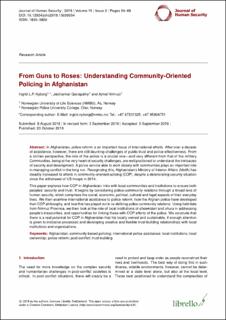| dc.contributor.author | Nyborg, Ingrid L. P. | |
| dc.contributor.author | Ganapathy, Jaishankar | |
| dc.contributor.author | Nimruzi, Ajmal | |
| dc.date.accessioned | 2020-07-09T09:40:52Z | |
| dc.date.available | 2020-07-09T09:40:52Z | |
| dc.date.created | 2019-11-18T15:35:26Z | |
| dc.date.issued | 2019 | |
| dc.identifier.citation | Journal of Human Security (JHS). 2019, 15 (2), 54-69. | en_US |
| dc.identifier.issn | 1835-3800 | |
| dc.identifier.uri | https://hdl.handle.net/11250/2661583 | |
| dc.description.abstract | In Afghanistan, police reform is an important focus of international efforts. After over a decade of assistance, however, there are still daunting challenges of public trust and police effectiveness. From a civilian perspective, the role of the police is a crucial one—and very different from that of the military. Communities, being at the very heart of security challenges, are well positioned to understand the intricacies of security and development. A police service able to work closely with communities plays an important role in managing conflict in the long run. Recognizing this, Afghanistan’s Ministry of Interior Affairs (MoIA) has steadily increased its efforts in community-oriented policing (COP), despite a deteriorating security situation since the withdrawal of US troops in 2014.
This paper explores how COP in Afghanistan links with local communities and institutions to ensure both peoples’ security and trust. It begins by considering police-community relations through a broad lens of human security, which comprises the social, economic, political, cultural and legal aspects of their everyday lives. We then examine international assistance to police reform, how the Afghan police have developed their COP philosophy, and how this has played out in re-defining police-community relations. Using field data from Nimruz Province, we then look at the role of local institutions of chowkidari and shura in addressing people’s insecurities, and opportunities for linking these with COP efforts of the police. We conclude that there is a real potential for COP in Afghanistan that his locally owned and sustainable, if enough attention is given to inclusive processes and developing creative and flexible trust-building relationships with local institutions and organizations. | en_US |
| dc.language.iso | eng | en_US |
| dc.rights | Attribution-NonCommercial-NoDerivatives 4.0 Internasjonal | * |
| dc.rights.uri | http://creativecommons.org/licenses/by-nc-nd/4.0/deed.no | * |
| dc.title | From guns to roses: Understanding community-oriented policing in Afghanistan | en_US |
| dc.type | Peer reviewed | en_US |
| dc.type | Journal article | en_US |
| dc.description.version | publishedVersion | en_US |
| dc.source.pagenumber | 54-69 | en_US |
| dc.source.volume | 15 | en_US |
| dc.source.journal | Journal of Human Security (JHS) | en_US |
| dc.source.issue | 2 | en_US |
| dc.identifier.doi | 10.12924/johs2019.15020054 | |
| dc.identifier.cristin | 1748990 | |
| cristin.unitcode | 192,13,1,0 | |
| cristin.unitcode | 192,0,0,0 | |
| cristin.unitname | Institutt for internasjonale miljø- og utviklingsstudier | |
| cristin.unitname | Norges miljø- og biovitenskapelige universitet | |
| cristin.ispublished | true | |
| cristin.fulltext | original | |
| cristin.qualitycode | 1 | |

